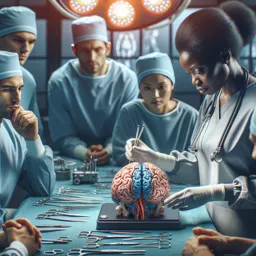
Free online courseMicrobiology
Duration of the online course: 8 hours and 26 minutes
Explore the fundamentals of microbiology, including bacterial structure, genetics, staphylococcus, toxins, and treatments for HIV, hepatitis, influenza, and herpes in this free course.
In this free course, learn about
- Bacterial Structure and Genetics
- Bacterial Pathogenesis and Treatment
- Antifungal Pharmacology
Course Description
Welcome to the comprehensive course on Microbiology, designed to provide an in-depth understanding of key microbiological concepts and applications. This course, with a total duration of 8 hours and 26 minutes, is meticulously crafted for students and professionals in the health and medicine sector, falling under the Health category and more specifically into the subcategory 'Others in Health and Medicine.' As this course is relatively new, it currently has no reviews yet, presenting a fresh opportunity for first-timers to dive into the material.
In this course, you will explore the fascinating world of bacteria, starting with their structure and function. You'll gain insights into the complexities of bacterial cells, how they are organized, and how their specific structures contribute to their survival and pathogenicity. Beyond mere memorization, this segment will offer a clear understanding of bacteria's biological roles and significance in health and disease.
The course then delves into bacterial genetics, helping you unravel the intricacies of genetic material in bacteria and how genetic variations and mutations contribute to antibiotic resistance, virulence, and adaptability. This foundational knowledge is critical for anyone looking to grasp the essentials of microbiological studies and their practical implications in medical science.
Next, you will encounter detailed sections on specific bacterial types, including Staphylococcus aureus, Staphylococcus epidermidis, and Staphylococcus saprophyticus. These segments will provide a thorough examination of their pathogenic mechanisms, epidemiology, and significance in clinical settings, equipping you with the expertise needed to understand why these bacteria are critical in health and disease management.
The course also provides a comprehensive comparison of endotoxins versus exotoxins. This crucial segment will enable you to distinguish between these two types of bacterial toxins, their mechanisms of action, and their roles in disease processes. Understanding these differences is vital for the diagnosis and treatment of bacterial infections.
Another pivotal aspect of this course is its focus on antibiotics, covering the various classes, mechanisms of action, and their uses in treating bacterial infections. You will also explore the world of antivirals with a special focus on HIV, hepatitis, influenza, and herpes treatment. This section aims to provide deep insights into how these drugs function, their therapeutic uses, and the challenges faced in antiviral therapy.
Finally, the course concludes with a significant exploration of antifungals, broadening your understanding of how these drugs are used to treat fungal infections. This segment will cover the different classes of antifungals, their mechanisms of action, and their clinical applications, ensuring a well-rounded understanding of microbial control in clinical practice.
Join us in this enlightening journey into microbiology and gain the expertise needed to excel in the health and medicine fields. Whether you’re a student or a professional, this course is designed to enhance your knowledge and provide practical insights into the microbial world.
Course content
- Video class: Bacteria | Structure and Function 1h04m
- Exercise: What is the primary function of bacterial endospores?
- Video class: Bacterial Genetics 40m
- Exercise: What is the primary method by which bacteria replicate to produce two identical cells?
- Video class: Staphylococcus: Aureus, Epidermidis, Saprophyticus 1h01m
- Exercise: Which of the following characteristics is NOT true about all staphylococcus species?
- Video class: Endotoxins vs. Exotoxins 44m
- Exercise: Which of the following statements is true regarding bacterial endotoxins and exotoxins?
- Video class: Antibiotics 2h17m
- Exercise: Which mechanism best describes how bacteria can prevent antibiotics from accumulating inside the cell?
- Exercise: What statement about antibiotics and bacterial cell wall synthesis is correct?
- Video class: Antivirals | HIV, Hepatitis, Influenza, Herpes Treatment 1h51m
- Exercise: Which of the following drugs is primarily used as an integrase inhibitor in the treatment of HIV?
- Exercise: Which enzyme is targeted by integrase inhibitors in the HIV replication cycle?
- Video class: Antifungals 46m
- Exercise: Which class of antifungal drugs works by forming pores in the fungal cell membrane, leading to electrolyte imbalances and subsequent cell lysis?
- Exercise: Which antifungal drug inhibits the enzyme squalene epoxidase, reducing the conversion of squalene to ergosterol, thereby affecting the stability of the fungal cell membrane?
This free course includes:
8 hours and 26 minutes of online video course
Digital certificate of course completion (Free)
Exercises to train your knowledge
100% free, from content to certificate
Ready to get started?Download the app and get started today.
Install the app now
to access the courseOver 5,000 free courses
Programming, English, Digital Marketing and much more! Learn whatever you want, for free.
Study plan with AI
Our app's Artificial Intelligence can create a study schedule for the course you choose.
From zero to professional success
Improve your resume with our free Certificate and then use our Artificial Intelligence to find your dream job.
You can also use the QR Code or the links below.

More free courses at Others in Health and Medicine
Download the App now to have access to + 5000 free courses, exercises, certificates and lots of content without paying anything!
-
100% free online courses from start to finish
Thousands of online courses in video, ebooks and audiobooks.
-
More than 60 thousand free exercises
To test your knowledge during online courses
-
Valid free Digital Certificate with QR Code
Generated directly from your cell phone's photo gallery and sent to your email

Download our app via QR Code or the links below::.











Course comments: Microbiology
Usiahon Joel
please always include the course material/s in all the courses. Thanks and God bless. love it